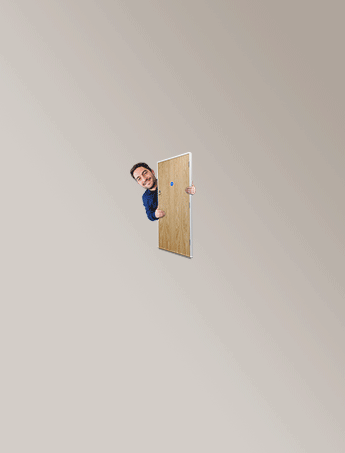This article is sponsored by CDC Garage Doors. As a specialist garage door installer and supplier, with over 15 years experience in providing high quality door solutions to both private households and developers, they share their expertise on durable door finishes.
When it comes to external finishes and materials, durability is essential to reduce maintenance cycles and the associated costs. One area that’s so often overlooked is garages, but there are several options for high-performing coating, laminates, and materials that will deliver exceptional longevity and contribute to the sustainability of your property while still enhancing its visual appeal.
Benefits of long-life external finishes for garage doors
Economic advantages
One of the most compelling reasons for investing in higher-quality finishes is the reduction in maintenance costs over the lifespan of your garage door. Traditional finishes might need repainting or staining every 3-5 years, whereas premium finishes will maintain their protective qualities for much longer. This translates to lower labour, material, and equipment expenses.
A well-maintained garage door also improves the marketability and value of your property. This makes it more appealing to buyers or tenants and can encourage higher asking prices or rental yields.
Operational benefits
From a business perspective, less maintenance means less disruption to your schedule or that of your tenants. Commercial and industrial applications benefit even more significantly, as disruptions can impact business operations and productivity. Long-life finishes reduce the frequency of these interventions, so occupants can enjoy uninterrupted use of their garage facilities.
For multi-storey or custom garage door designs, fewer maintenance interventions also reduce the need for working at height, which then improves overall safety for maintenance personnel. This is particularly relevant for commercial and industrial installations where garage doors may be located in challenging positions or integrated into complex building facades.
Environmental Goals
Longer-lasting finishes mean fewer resources are expended on manufacturing replacement materials and less waste ends up in landfills. The environmental impact of frequent repainting doesn’t just include the paint itself but also the solvents, cleaning materials, protective equipment, and packaging associated with each maintenance cycle.
Specifying durable components for property exteriors contributes to the overall sustainability goals of the building and can help you achieve green building certifications such as BREEAM, LEED, or similar standards. Many green building certification schemes award points for specifying durable materials and systems that reduce long-term environmental impact. This can be particularly valuable for commercial developments seeking to achieve specific sustainability targets or certifications.
Types of external finishes for garage doors
High-performance coatings and paints
Polyester powder coatings offer the gold standard for garage door finishes, offering exceptional durability, weather resistance, and aesthetic versatility. Applied electrostatically and cured at high temperatures, these coatings form a dense, uniform film that provides superior protection against corrosion, UV degradation, and mechanical damage. Available in virtually unlimited colours and textures, polyester powder coatings typically offer 15-20 year warranties and can maintain their appearance for even longer in favourable conditions.
Polyvinylidene Fluoride coatings (PVDF) offer unparalleled weather resistance and colour retention. Originally developed for aerospace applications, these coatings provide exceptional resistance to UV radiation, chemical attack, and thermal cycling, and are therefore particularly valuable in harsh environmental conditions.
High-quality PVC foils and laminates are great if you’re looking for an economical approach. Modern PVC systems incorporate UV stabilisers, impact modifiers, and advanced adhesive technologies to ensure long-term performance. They’re particularly popular for residential applications where aesthetic variety is important, as they can replicate wood grain, stone textures, or contemporary smooth finishes.
Advanced acrylic film systems offer excellent optical properties, weather resistance, and conform easily to complex designs. These films are particularly suitable for retrofit applications or situations where traditional coating processes are impractical. High-performance acrylic films can provide 10-15 year service life while offering easy installation and minimal substrate preparation requirements.
Resilient panel materials
Insulated panels combine structural performance with thermal efficiency and work with any of the high-performance coatings listed above. The steel substrate provides excellent coating adhesion and mechanical properties, while the insulation core enhances energy efficiency and reduces thermal bridging.
Composite materials like GRP combine the aesthetic appeal of natural timber with enhanced durability and reduced maintenance requirements, which gives you the best of both worlds. These engineered materials incorporate weather-resistant resins, UV stabilisers, and fungal inhibitors to provide long-term performance without the seasonal maintenance associated with natural timber.
Specifying finishes for your garage
Several factors influence the type of finish you’ll need for your garage door. The first involves the environment—coastal locations present unique challenges, for example, because they expose the door to salt spray which can accelerate the corrosion of metallic substrates and degrade certain coating systems. In these locations, PVDF coatings or anodised aluminium panels often provide the best long-term performance.
Similarly, industrial environments might expose your garage door to chemical pollutants, elevated temperatures, or mechanical contamination that necessitates specialised finishes, while urban environments typically present challenges related to air pollution, UV exposure, and potential vandalism or graffiti.
Substrate materials
If you’re upgrading your existing garage door, you also need to think about the substrate material and how well it will adhere to new finishes. Steel substrates require appropriate surface preparation and primer systems to ensure long-term adhesion and corrosion protection, whereas aluminium substrates typically provide excellent coating compatibility but might require specific surface treatments to maximise adhesion.
Long-life finish systems should be evaluated across multiple criteria to ensure suitability for specific applications. Weather resistance encompasses UV stability, thermal cycling performance, moisture resistance, and resistance to specific environmental contaminants. Mechanical properties include impact resistance, abrasion resistance, and flexibility to accommodate substrate movement.
Naturally, your garage door should complement rather than compete with other building elements. But functionality is vital for saving money, resources, and time. This is where durable door finishes and materials can be beneficial to keep the look and feel you’re striving for without the need for constant maintenance or repairs.





